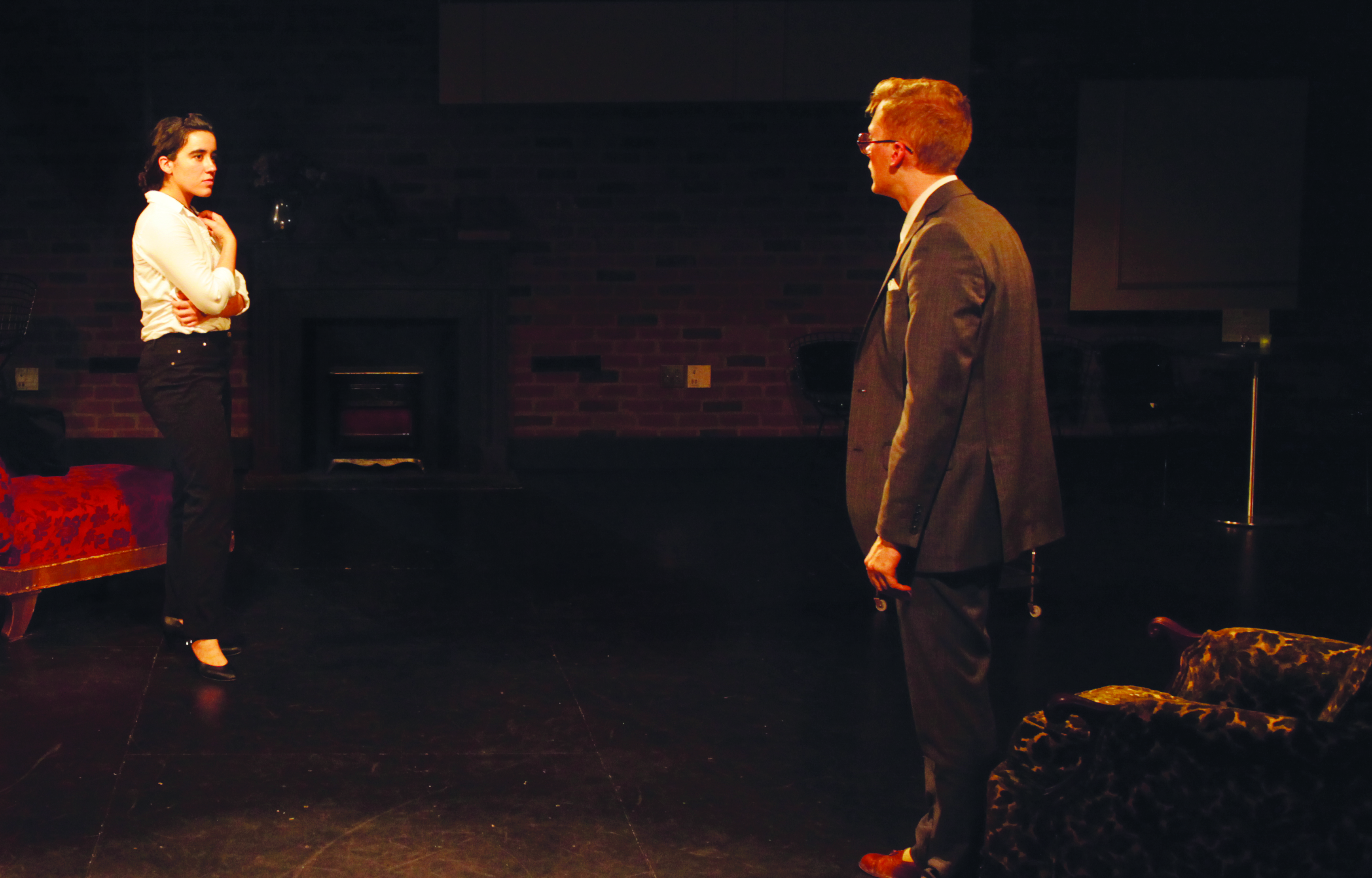
The play is at 8 p.m. on a Thursday night, at the Calhoun Cabaret. The Cabaret itself is finely furnished with a gaudy and ornate design in the style of the Second French Empire. Indeed, it extends outwards, with grandiose empty frames enclosing the audience in its invisible borders. Of course, the action takes place in front of the sitting spectators, but the stage has no demarcated boundary. We are in the room, and we soon discover we’re also in Hell — a setting that is funnily reflective of Sartre’s feelings about occupied Paris, where he lived at the time he wrote the play in 1944.
The story begins with a meek-seeming man, a journalist from Rio named Garcin who is led into the neatly adorned room by a rather sterile and disturbingly composed valet. Garcin, as portrayed in this production, is effeminate and well-dressed, and whose words don’t coincide with his behavior. After some conversation, the valet leaves Garcin alone in the room with the door locked. He proceeds, after a short time, to throw a hysterical fit, banging on the door for an immeasurably long time, finally giving up and sitting in despondent fashion on a spinach-colored chair.
Enter character number two: Inez. Inez, over the course of the play, reveals herself as a cruel and callous character, a lesbian post-office worker who is sternly repulsed by men and quickly makes this clear to Garcin. Inez possesses a near-constant gaze of hawkish amusement. Her expression varies at some points, such as the few moments she feels some level of remorse, but certainly her words are those of a manipulative sadist. Her malevolence was to me the most perturbing part of the play, perhaps because it was so prominent that I was forced to ruminate on it.
These two distinct characters proceed to interact, and Inez soon displays her abilities to attach emotional tendrils to those around her and while Garcin reveals his susceptibility to others’ opinions. During their verbal knife fight, they realize that there are no mirrors in the room. In essence, they are each other’s definition. Because they have left behind both the earthly world and their material bodies, as well the mirrors, the only source of self-image each one can possess is that relayed by the other. This is exemplified in a moment between Inez and Garcin during which the two, waiting for something to happen, pick two of three chairs in the room in which to bide their time. In the meanwhile, Garcin makes rather annoying movements with his mouth, driving Inez to fury. She barks at him for his contorted face; Garcin can’t contest this accusation, given the only evidence for his image is the remark from Inez, and so he believes her image of him. This concept is repeated in the play frequently and fervently, most notably with the addition of a third damned soul: Estelle.
Estelle is the character of pivoting action between Garcin and Inez’s conversation. Estelle hails from high society and in life was married to a wealthy man; Estelle’s pretty entrance is only marred through her screaming about a faceless man whom she appears to know from her past. Estelle would have enjoyed her name being repeated as much as I have above — she is portrayed as shifty, easily bothered and resistant to acknowledge the wrongs she committed during her stay on Earth.
What follows in the play is the pure expression of what is perhaps Sartre’s most famous and misunderstood line: “Hell is other people.” No punishments comically reflective of their cause appear, no demons with pitchforks and pent-up phallic rage descend to skewer the characters, and no devil assumes shape, even as a suave man with puny horns adorning his head. No, Hell for each character is indeed the others, for each one depends entirely on the opinion on the others for their own identity. Inez depends on her victims, Garcin depends on Inez believing he was a man and not a coward, and Estelle can’t define herself without a man. So bound to each other are they that even during the moment when they have the chance to escape the bowels of their 18th-century furnace, no one leaves. It is a sentimental play, and is performed as such. And the final questions remain after the show ends, stuck to the shell of everyone’s heads — how bound are we to the eyes of others? Do we subscribe too much to what others think to validate our own existence? And it was these questions that harangued my inner ear as I walked away from Calhoun, waiting on the edge of Elm Street for a moment to pass.







